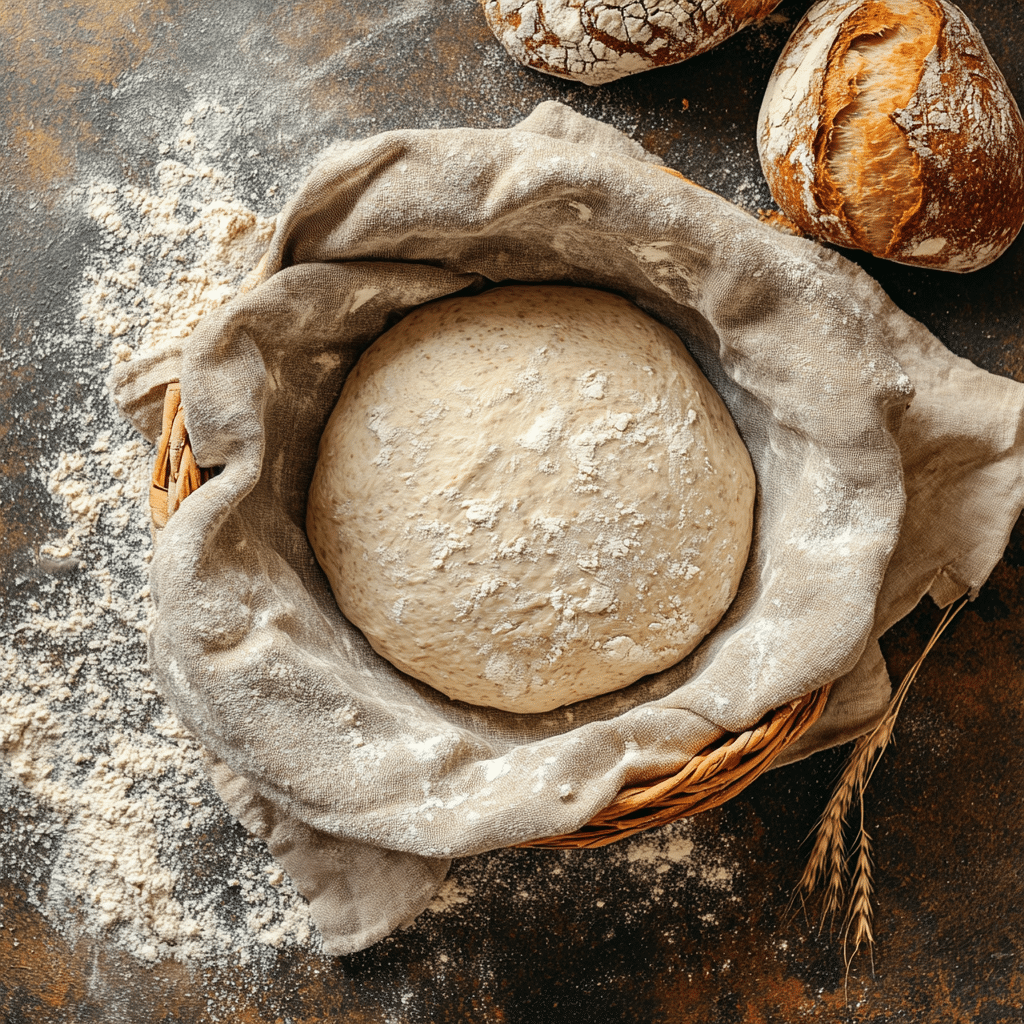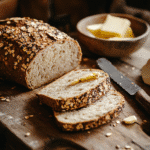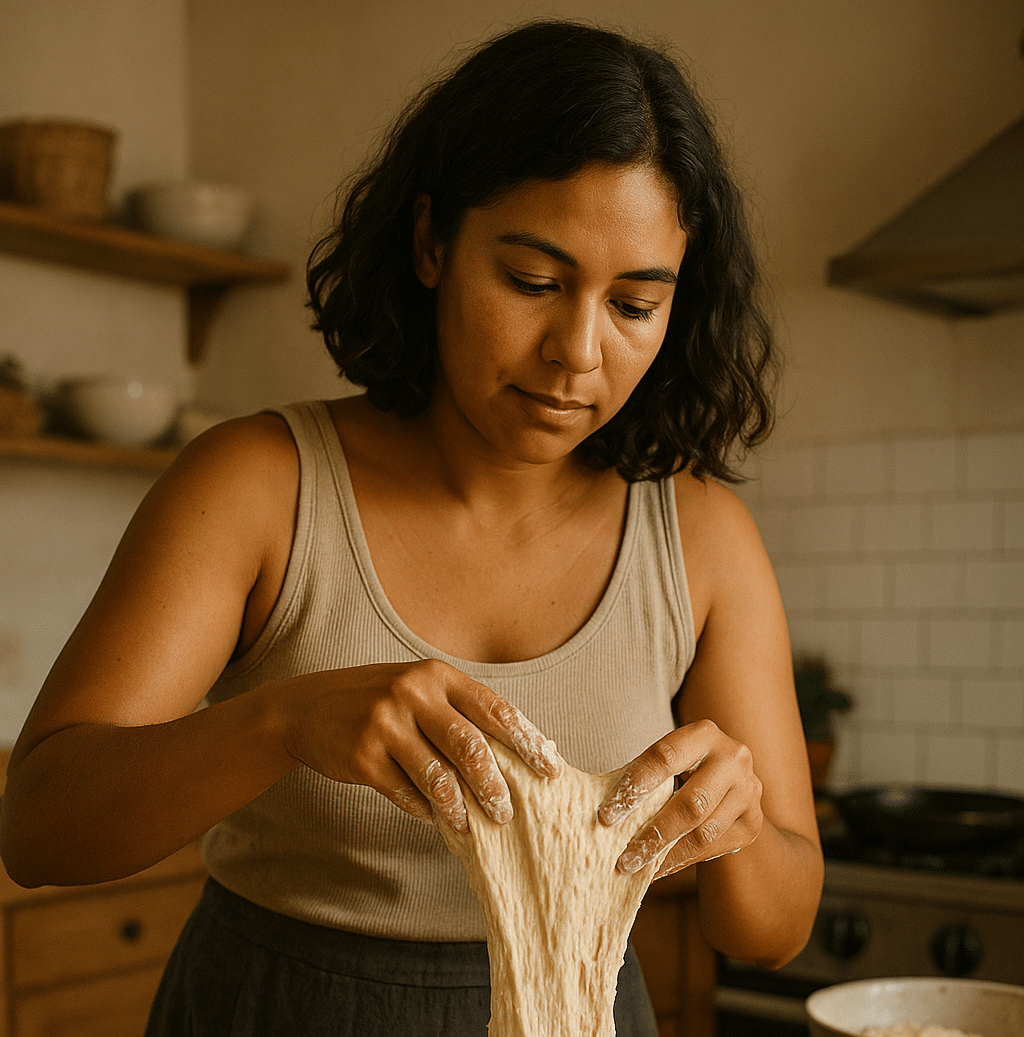If you’ve been searching for a hearty, wholesome sourdough multigrain recipe that brings both flavor and nutrition to the table, you’re in for a treat. Multigrain sourdough isn’t just a trend—it’s a satisfying staple that combines the gut-boosting benefits of sourdough fermentation with the nourishment of whole grains. This guide will walk you through every detail, from starter prep to final bake. Whether you’re adding rye, spelt, flax, or oats, this recipe invites depth, texture, and rustic charm into your bread. Let’s craft a loaf that nourishes both body and spirit, the way sourdough was always meant to.
Why multigrain sourdough is more than just a recipe
From One Jar to a Journey of Grains
Welcome, kindred baker. I’m Emma, and I believe every loaf has a story—mine began with a jar of flour, water, and a little leap of faith. When I first made my sourdough starter, I was just hoping for bubbles. What I didn’t expect was how much it would ground me. Somewhere between my third successful boule and a surprisingly chewy spelt sourdough bread, I began layering in more than just wheat.
I added oats, rye, seeds, even flax. My sourdough multigrain recipe was born not from perfection, but from a craving—something deeper, earthier, more nourishing. That first slice was golden and crackled with promise. It wasn’t just bread. It was a revelation. And you know what? You don’t have to be an expert to get there.
Why Sourdough Multigrain Bread Feels Different
This sourdough multigrain recipe brings the best of two worlds: wild fermentation and diverse nutrition. Unlike typical whole wheat loaves, multigrain sourdough allows your starter to unlock the natural sweetness in grains like spelt, barley, and oats. It also gives your bread that open, chewy texture we all love—like the airiness in sourdough ciabatta, but with more substance.
The long fermentation helps break down gluten and phytic acid, which makes the grains easier to digest and their minerals more bioavailable. That’s part of what makes this kind of bread deeply satisfying—not just to eat, but to bake. When you feel that dough tighten under your palms or hear the crust sing out of the oven, it’s a full-sensory reward.
And here’s the thing: this isn’t a fancy loaf made for Instagram. This is a loaf you slice thick, toast with butter, and eat with your morning coffee. It’s bread for living. Bread that invites you to slow down and savor what you’ve made. We’ll start simple—but by the end, you’ll feel confident enough to riff, fold in your own grains, and maybe even transform your leftover discard into golden focaccia while you’re at it.
Choosing Grains for Your Multigrain Sourdough

Whole Grains That Play Well with Sourdough
Not all grains behave the same once they meet sourdough fermentation. The key to a successful sourdough multigrain recipe lies in the blend—how grains complement your starter’s activity, contribute to crumb structure, and build flavor over time. A strong base usually starts with whole wheat or spelt flour, providing both fiber and fermentation-friendly sugars. These flours help anchor your dough, while lighter additions like rolled oats, flaxseed, and millet bring nuance and texture.
Rye is especially powerful in sourdough. It ferments faster than wheat and lends a deep, earthy note that pairs beautifully with the tanginess of natural leavening. Just don’t overdo it—too much rye can turn your loaf dense. For best results, use no more than 20–30% rye in your total flour mix.
And let’s not forget the seeds: sunflower, sesame, and flax are great options. Toasting them beforehand releases their oils, intensifying flavor. For hydration’s sake, it’s wise to soak or scald your grains before folding them into the dough. It keeps them soft through the bake, avoiding unpleasant crunch or moisture stealing.
For a flavor-packed alternative to basic white bread, you might find inspiration in our tangy San Francisco-style sourdough, which can also handle whole grains surprisingly well.
The Healthiest Flours to Use for Sourdough
When choosing flours for your sourdough multigrain recipe, it’s not just about taste—it’s also about nutrition. Whole grain flours retain the bran, germ, and endosperm, making them rich in fiber, B vitamins, and minerals like zinc and magnesium. Spelt is a favorite: it has a mild, nutty flavor and contains slightly more protein than all-purpose flour. Einkorn and emmer are also ancient grains that play well with sourdough, offering digestibility and a flavor boost.
So what’s the healthiest flour? Nutritionists often point to whole rye for its ability to regulate blood sugar, followed closely by stone-ground wheat. But the real benefit lies in fermentation—sourdough culture partially pre-digests these grains, reducing their glycemic load and making nutrients more accessible.
If you’re gluten-sensitive but not celiac, you might explore our gluten-free sourdough discard recipe to see how fermentation can still work magic with alternative flours.
Whichever grains you pick, remember: multigrain sourdough isn’t about stuffing every seed and kernel into one dough. It’s about balance—getting the chew, crust, and nutrition just right. With a thoughtful blend, you’re building a bread that supports your gut, your palate, and your everyday table.
The Process Behind a Great Sourdough Multigrain Recipe
Mixing and Folding: Respecting the Dough
Every sourdough multigrain recipe begins with patience and intention. Once you’ve chosen your grains, it’s time to mix them into a dough that truly shines. Start with your whole grain flours—spelt, whole wheat, and rye are excellent for a balanced sourdough multigrain bread. Mix them with warm water and let the mixture rest for a classic autolyse. This essential step helps break down starches and makes folding easier later on.
After resting, add your active sourdough starter and sea salt. Blend them gently until combined. This sourdough multigrain dough should feel slightly tacky but cohesive. Over the next 4–5 hours, perform 3 to 4 rounds of stretch and folds. It helps develop gluten and ensures the soaker grains—like flax, oats, or sesame—are well-distributed.
If you find yourself with extra starter after mixing, you can transform it into something delicious like discard bagels or even sourdough focaccia while your dough ferments.
This part of the sourdough multigrain recipe teaches you to read your dough—feel for elasticity, watch for a soft puff, and notice how the grains integrate. Your bread will thank you for not rushing.
Shaping and Baking: Crust, Crumb, and Character
Once bulk fermentation finishes, your sourdough multigrain dough is ready to be shaped. Dust your bench and prepare a banneton or floured bowl. Gently shape the dough into a boule or batard, maintaining surface tension.
Place it in the fridge overnight. This cold ferment deepens the flavors and gives this multigrain sourdough recipe its signature tang. When you’re ready to bake, preheat a Dutch oven to 475°F. Bake covered for 20 minutes, then uncover and finish until the crust darkens and cracks beautifully.
The result is everything you want from a sourdough multigrain bread—chewy, moist, nutty, and flavorful. The soaked grains remain soft, the crust shatters on the first bite, and the aroma fills your kitchen.
If you run into issues with your starter, check out our article on how to fix moldy sourdough starter. A healthy starter is the heart of every successful sourdough multigrain recipe.
This is the kind of bread you’ll want to make every week. It’s hearty enough for sandwiches, lovely toasted with butter, and the kind of recipe that becomes a tradition in your home.
Making Sourdough Multigrain a Lifestyle

Smart Storage & Weekly Baking Tips
Once you’ve nailed your sourdough multigrain recipe, it becomes more than a one-time bake—it becomes part of your rhythm. The great thing about sourdough multigrain bread is how well it keeps. Thanks to the natural acidity from fermentation, it stays fresh longer than store-bought loaves.
Wrap your cooled loaf in a clean linen or store it in a bread box. Avoid plastic—it traps moisture and can ruin that perfect crust. If you won’t finish it in 3 days, slice and freeze it. Toast slices straight from the freezer for a convenient, hearty breakfast.
Batch baking this sourdough multigrain recipe once a week is a time-saver. Mix two loaves at once, and keep one in the freezer. If you want more variety, you can alternate grains each week—swap in barley, cracked wheat, or even millet. The core recipe stays the same, but the flavor evolves with your pantry.
Even your discard can keep up—use it for weekend sourdough pizza dough or soft pretzel bread that still nourishes and delights.
Serving Ideas & Health-Forward Habits
Multigrain sourdough isn’t just healthy—it’s versatile. This sourdough multigrain recipe pairs beautifully with both sweet and savory toppings. Spread it with almond butter and honey for a protein-rich snack, or stack it high with roasted veggies and hummus. Its chewy interior and crisp crust make it ideal for open-faced sandwiches, hearty breakfasts, or an evening cheese board.
Because this recipe uses fermented whole grains, it’s easier on the digestive system and can be more blood sugar–friendly than conventional bread. The fermentation process reduces phytic acid and improves mineral absorption, making this multigrain sourdough recipe not just tasty, but truly functional food.
As you build the habit of baking and eating this loaf, you’ll likely notice a difference—not just in your kitchen, but in your energy and well-being. Sourdough has a way of slowing life down, helping you reconnect with real food and your own hands. And isn’t that the best kind of nourishment?
Sourdough Multigrain Recipe Questions Answered
Can sourdough be multigrain?
Absolutely. Sourdough is incredibly adaptable, and this sourdough multigrain recipe proves it. By combining your starter with flours like rye, spelt, or whole wheat and folding in soaked seeds or grains, you get a loaf that’s flavorful, textured, and nutritious.
Is multigrain sourdough bread healthier?
Yes—multigrain sourdough bread contains more fiber, protein, and minerals than white bread. Plus, fermentation boosts digestibility and reduces gluten and anti-nutrients. That’s why this sourdough multigrain recipe is both gut-friendly and satisfying.
What is the biggest mistake you can make with your sourdough starter?
Neglect. A neglected starter becomes sluggish or unsafe. The biggest mistake is ignoring signs of imbalance—like mold, bad smells, or poor rise. If you’re unsure, our starter troubleshooting guide can help you get back on track.
What’s the healthiest flour to make sourdough with?
Whole grain flours like rye, spelt, and stone-ground wheat rank highest. They retain the germ and bran, offering more nutrients. This sourdough multigrain recipe uses a blend of them to maximize both flavor and health benefits.
follow us in Pinterest
Conclusion
A good sourdough multigrain recipe does more than feed you—it connects you to time, texture, and tradition. With the right flours, grains, and a little rhythm in the kitchen, you’ll bake loaves that are hearty, healing, and full of soul. Whether you’re just starting or looking to expand your repertoire, this multigrain sourdough bread is a beautiful, delicious place to grow.


Sourdough Multigrain Recipe: A Rustic Loaf with Real Soul
- Total Time: 14 hours 45 minutes
- Yield: 1 loaf
- Diet: Vegetarian
Description
Hearty and rustic sourdough multigrain bread with whole grains, seeds, and natural fermentation.
Ingredients
400g bread flour
100g whole spelt flour
50g rye flour
75g rolled oats (soaked)
25g flaxseeds (soaked)
100g active sourdough starter
375g water
10g salt
Instructions
1. Mix flours, soaked oats and flax, and water. Let rest 1 hour (autolyse).
2. Add sourdough starter and salt. Mix until combined.
3. Perform 3–4 stretch and folds over 4 hours of bulk fermentation.
4. Shape dough and place in floured banneton. Cover and refrigerate overnight.
5. Preheat Dutch oven to 475°F. Bake covered for 20 minutes, then uncovered for 20–25 more.
6. Cool on wire rack before slicing.
Notes
Soak oats and flax in warm water 1–2 hours before mixing.
Optional: Add sunflower seeds or sesame for extra crunch.
Use rice flour to dust your proofing basket to avoid sticking.
- Prep Time: 14 hours (includes overnight proof)
- Cook Time: 45 minutes
- Category: Bread
- Method: Baking
- Cuisine: Rustic





